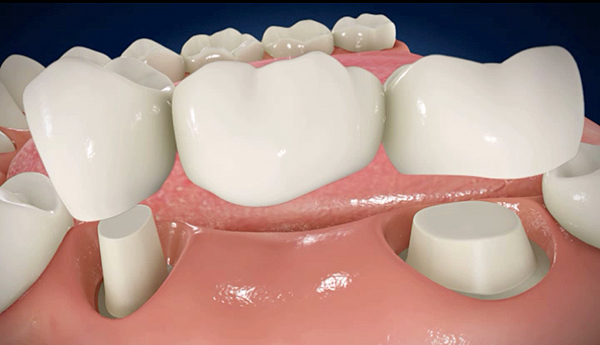Working Time
- Mon-Fri 09:30am - 20:30pm
Sat 10:00am - 20:30pm
Sun Closed
Contact Info
-
Phone: 011-25291118
9716972820
Crown & Bridges

A dental crown is a fixed prosthetic “cap” that fits over a damaged tooth and restores it to its normal appearance and function. It can be molded from several different materials, including ceramics, porcelain-and-metal, gold, and resin. Crowns duplicate the shape and size of the original tooth and effectively replace the top of a damaged tooth.
Dental bridges are meant to “bridge the gap” created when one or more teeth are missing from a mouth. Bridges consist of at least two dental abutment crowns and at least one false tooth (called a “pontic”), all created together as one solid piece. The pontic fits into the area where the tooth is missing. The abutment crowns fit onto the teeth on either side of the gap to support and anchor the pontic. Ultimately, bridges fill in missing teeth and help replace healthy tooth structure after damage.
The procedure refers to the restoration of natural teeth that have been damaged, decayed or lost. Their benefits are that they restore tooth function, shape or alignment, and appearance. The use of crowns and bridges also avoid shifting teeth that can happen after a tooth is lost.
What Are Crowns And Bridges Used For?
Crowns and bridges are very common dental restorations because of their utility. Each restoration can be used to solve several problems, such as:
- Cracked, Damaged, Or Broken Teeth
- Gaps Between Teeth
- Discolored Teeth
- Missing Teeth
- Consistent Or Intermittent Tooth Pain
- Teeth That Are Very Sensitive To Temperature
- Pain When Brushing Your Teeth
- Pain When Chewing

What happens during a dental crown procedure?
Your dentist will usually prepare the tooth by removing a layer of the outer surface of the tooth. The crown will be the same thickness as the thickness of this removed layer.
To make a crown, your dentist takes a mould of your tooth and sends it away to a technician who will prepare the crown. It can often be matched to the colour of your teeth, so it will blend in.
You might be given a temporary crown to get you through until the permanent crown is made.
When your permanent crown is ready, you’ll go back to the dentist and have it fitted using dental cement or adhesive.
How do you care for your dental crown?
Although your crown can’t decay, the edge of the tooth on which it sits can. You will need to brush your teeth with fluoride toothpaste and floss your teeth, as is usually recommended.
Benefits and risks of a dental crown procedure
Crowns are a way of protecting teeth that are weak or have been broken. They also help improve the appearance of teeth that are irregularly shaped or stained. Crowns can last many years if they are cared for properly.
But sometimes they break or fall off. This might be because the cement doesn’t hold, or it might be because the tooth under the crown has decayed.
Alternatives to dental crowns
There are alternatives to dental crowns. If you want to improve discolouration, then veneers - which are thin layers fixed onto the front surface of a tooth - might be an option. If your tooth is chipped, your dentist may also try to rebuild your tooth structure using filling material.

